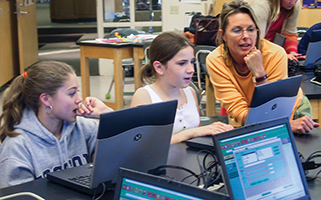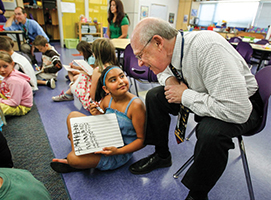Accelerating Access to the Curriculum
November 01, 2015

The architectural concept of universal design revolutionized our thinking about access to buildings, streets and playgrounds. Access issues were considered endemic to persons with certain physical disabilities — they had the problem and they were responsible for adjusting to the environment.
What reframed our thinking was the realization that the problem existed not in the users but rather in a deficient design that failed to accommodate people’s natural variability. As universal design became commonplace, architects and city planners discovered that a wide array of individuals — those using bicycles and baby strollers or those who simply enjoyed the incline of a ramp — took advantage of the alternative access. Universal design benefited everyone.
In similar fashion, universal design for learning, or UDL, is transforming access to the curriculum. And just as universal design revolutionized architectural design, UDL is revolutionizing curricular design and instructional planning by providing the academic curb cuts and other pathways that facilitate access to core concepts and skills development by all students.
Curriculum Centric
As school and district leaders, we want to help teachers meet the learning needs of students with disabilities and of varied cultural, language and economic backgrounds. We understand that students learn in varied ways and may require different strategies to achieve the same goals. Our challenge is to plan for that natural variability and make the means of learning as flexible as possible while upholding essential goals.
Our traditional approach to teaching is curriculum-centric — that is, students’ success in mastering the curriculum places them along a spectrum from gifted to average to failing or disabled. By contrast, UDL contends that the underlying cause of inadequate mastery is not the disability of the learner but rather the “disability” of a text- and print-dominated curriculum that fails to support and accommodate learners’ diversity.
Our discovery that ramps and auditory traffic cues aid persons beyond those with disabilities has informed the UDL approach to curriculum. Instead of focusing on fixing problems, UDL strives to make all options as widely available as possible to support every student. More than just acknowledging variability in learning, UDL accepts it as the norm and argues we should plan for it.
UDL’s principles were articulated first in the 1990s by a Massachusetts nonprofit known as CAST (www.CAST.org), which today serves as the national center for UDL policy, research and professional development. Central to UDL’s effectiveness is predesigning curriculum and instruction to include flexible options that address the natural and predictable variability among students. Through intentional planning that removes barriers within a learning environment, we can eliminate circumstances that contribute to failure.
CAST developed a framework to support teachers and curriculum developers in their planning and instructional design. Within that framework, UDL offers all students access to the curriculum by accommodating three systematic dimensions of variability: How students understand information, how they engage in learning, and how they express their learning. Because these dimensions are predictable, we can plan for them in advance and provide students with multiple ways to encounter new knowledge, participate in the learning experience and demonstrate their understanding and growth.

Means of Representation
Formal instruction long has been dominated by verbal communication and print media, which pose a barrier for some students. By instead presenting a lesson through a variety of modalities, media and materials, teachers can address differences in how learners perceive, interpret and understand information. The routine incorporation of digital, video, audio and imaging options provides broader access to key concepts and skills.
For example, a classroom setting can provide a variety of media to learn about a subject with students selecting the media that feel most comfortable for their learning needs. Students choose among multiple stations that include books to read, audio selections, text-to-speech reading of material and video. They can select more than one station, thereby gaining various perspectives on the same topic.
Although each student may do something different, the options enable all students to focus on the same learning target together and to enter the learning experience with confidence because they have been able to access and understand the material in a way that works for them.
Means of Engagement
Sparking students’ interest is key to effective learning, yet each student may be motivated by different ways of engaging with the material. Choice and options are by their very nature motivational. Making individual choices about how to access information, what challenge level to take on and what medium to use to demonstrate understanding are effective ways to support a high level of investment and ownership of learning.
By offering many ways to connect with concepts, teachers both enrich the learning environment and enable students to choose how they want to interact with the content. Teachers can provide various entry points by planning instruction that builds in options for hands-on applications, simulations, puzzles and games, real-world problem-solving exercises, collaborative group activities or other avenues that enlist student participation and engagement.
Using these multiple options as a base for individual and group projects encourages students to explore the material in a variety of ways and is an effective strategy for addressing learner variability. Access to varied technology tools and applications further broadens the vehicles for that engagement. Given the freedom to choose how to interact with the material, students become more engaged in their learning and assume more responsibility for their learning.
Means of Expression
We often assume that fairness demands all students express their understanding or be assessed the same way. However, to generate the most meaningful performance data, students should be encouraged to exhibit their learning in multiple ways and times. Allowing for such variability enhances students’ understanding and engagement while providing richer data on the degree to which the curriculum and instruction are effective in supporting student learning.
One of the critical differences in the UDL approach is that scaffolding and supports are built into assessment to ensure the accuracy of the construct being assessed and to enhance students’ ability to focus on the core task. For example, in an assessment of the main idea of a reading passage, providing supports such as text to speech, an online graphic organizer or integrated highlighting may enable students to accomplish the task successfully.
Similar supports have been incorporated into such summative assessments as the Smarter Balanced assessment of Common Core standards used by 18 states last spring. Smarter Balanced embedded into its assessment instrument “universal tools,” such as a calculator, digital notepad, highlighter, glossary and spell check; “designated supports,” such as a translator, text to speech, masking, color contrast and magnification; and “accommodations,” such as braille, closed captioning and American Sign Language. New diagnostic technology also enables students to experience ongoing self-monitoring with mastery-oriented feedback that promotes reflection and ownership.
Supporting Variability
With professional development and collegial support, teachers can — and often do — make adjustments to their instructional strategies. However, the cutting edge of UDL work is in the redesign of curriculum and materials to enhance their accessibility and flexibility. This is where technology can play a key role by embedding flexibility in how materials are accessed, how supports are provided and how the student and teacher measure progress.
Multimedia tools, simulations and animations provide multiple means of presenting material. Digital and online tools help us create scaffolding that enables students of all ability levels to fully access the concepts being taught — tools such as text to speech and speech to text; hyperlinked multimedia dictionaries and glossaries; links to background information and multimedia source material; embedded rubrics and exemplars; graphic organizers, checklists and integrated highlighting; electronic notepads and interactive concept maps; and voice threads and onscreen coaching through animated hints.
In addition, a growing body of online analytics accompanies new curricula and charts progress in multiple dimensions, not just the correctness of answers — thereby providing sophisticated diagnostic information that can further refine our instructional effectiveness and targeted assistance.
As school districts adopt digital curriculum in one-to-one environments, we need to evaluate these materials against a new scale that measures the degree to which they are universally designed and offer multiple means of representation, engagement and expression, as well as a full array of supports for student success.
Reframing Teaching
Universal design for learning reframes the way we think about diversity in the classroom and enables teachers and schools to effectively reach and engage a far broader range of learners. The basic tenet of UDL is that all children can learn if we create multiple avenues of accessibility to the learning targets. Rather than seeing inability or disability in our students, we recognize natural variability.
Through UDL, customization and personalization are built into curriculum and instruction so that students can access the tools, strategies and supports they need to succeed. In this way, the UDL framework also helps address cultural and language differences and the achievement gap common to low-income students and students of color.
Though we have learned much about how to design accessible curriculum and instruction, we are still in the early stages of systemic transformation. A few states now extend leadership and support for embedding UDL in state policies and district practices.
As we select new materials, plan new instructional lessons and work with colleagues to provide the collective scaffolds necessary for student learning, we should ensure our choices and decisions embody the principles of universal design for learning. We need to seek out professional development that will develop UDL-related attitudes and aptitudes districtwide. And we need to become the architects and outspoken champions of classrooms, schools and districts where every student is offered effective on-ramps to positive engagement with a full curriculum and higher levels of achievement.
Additional Resources
Readers seeking more detailed information about the universal design for learning and its application to K-12 education can access these resources:
Websites
- CAST UDL Exchange, http://udlexchange.cast.org. A place to build and share resources, including lesson plans. Free registration provides access to other resources from CAST, such as UDL Book Builder, UDL Studio and Science Writer.
- National UDL Center, or CAST www.udlcenter.org. An all-purpose website, operated by a nonprofit organization, with tabs on implementation, policy, research and practice that also houses the UDL Guidelines and UDL Connect, a community of practice.
- Universal Design for Learning: Theory and Practice, http://udltheorypractice.cast.org. A multimedia, full-text edition is offered at no charge (free registration required), with more than 45 videos and extended references and notes.
Books
- Design and Deliver: Planning and Teaching Using Universal Design for Learning by Loui Lord Nelson, Brookes Publishing, 2012
- Teaching Every Student in the Digital Age: Universal Design for Learning by David H. Rose and Anne Meyer, ASCD, 2002
- UDL Now! A Teacher’s Monday-Morning Guide to Implementing the Common Core Standards Using Universal Design for Learning by Katie Novak, CAST Professional Publishing, 2014
- Universal Design for Learning: Theory and Practice by Anne Meyer, David H. Rose and David Gordon, CAST Professional Publishing, 2014
- Universal Design for Learning in the Classroom: Practical Applications edited by Tracey E. Hall, Anne Meyer and David H. Rose, Guilford Press, 2012
Advertisement
Advertisement
Advertisement
Advertisement


.png?sfvrsn=3d584f2d_3)
